What happen to the food we eat after digestion to give us energy.
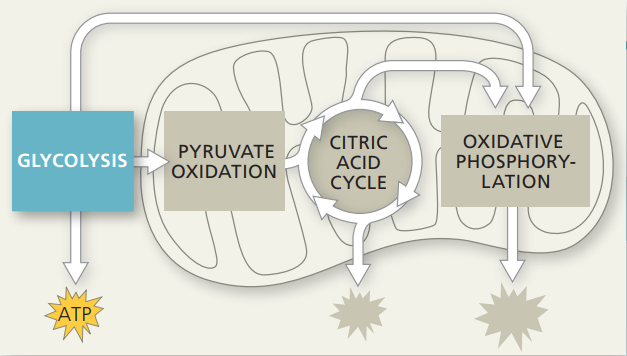
Content:
Cellular respiration
Phases of Cellular Respiration
Glycolysis
- Phosphorylation
- Lysis
- Phosphorylation
- Dehydrogenation and formation of ATP
Oxidative decarboxylation (the link reaction)
The Krebs Cycle/ Citric Acid Cycle
- The importance of coenzymes in respiration
The electron transport chain (ETC)/ Oxidative phosphorylation reaction
Substrate level phosphorylation
Cellular respiration
Cellular respiration is the process by which cells acquire energy by breaking down nutrient molecules produced by photosynthesises.
Its very name implies that cellular respiration requires oxygen (O2) and gives off carbon dioxide (CO2).
In fact, it is the reason any animal, such as an ocelot or human, breathes and why plants also require a supply of oxygen.
Most often, cellular respiration involves the complete breakdown of glucose to carbon dioxide and water (H2O).
Phases of Cellular Respiration
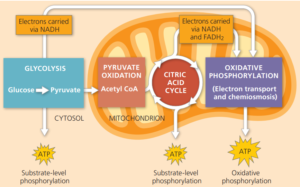
Cellular respiration involves four phases: glycolysis, the preparatory reaction, the citric acid cycle, and the electron transport chain.
Glycolysis takes place outside the mitochondria and does not require the presence of oxygen. Therefore, glycolysis is anaerobic.
The other phases of cellular respiration take place inside the mitochondria, where oxygen is the final acceptor of electrons.
Because they require oxygen, these phases are called aerobic.
During these phases, notice where CO2 and H2O, the end products of cellular respiration, and ATP are produced.
-
Glycolysis:
Is the breakdown of glucose to two molecules of pyruvate.
Oxidation results in NADH and provides enough energy for the net gain of two ATP molecules.
-
The preparatory (prep) reaction/ Oxidative decarboxylation/the link reaction.
This takes place in the matrix of the mitochondrion.
Pyruvate is broken down to a 2-carbon (C2) acetyl group, and CO2 is released.
Since glycolysis ends with two molecules of pyruvate, the prep reaction occurs twice per glucose molecule.
-
The citric acid cycle/ The Krebs Cycle
Also takes place in the matrix of the mitochondrion.
As oxidation occurs, NADH and FADH2 results, and more CO2 is released.
The citric acid cycle is able to produce one ATP per turn.
Because two acetyl groups enter the cycle per glucose molecule, the cycle turns twice.
-
The electron transport chain (ETC)/ Oxidative phosphorylation reaction
Is a series of carriers on the cristae of the mitochondria.
NADH and FADH2 give up electrons to the chain.
Energy is released and captured as the electrons move from a higher-energy to a lower-energy state.
Later, this energy will be used for the production of ATP by chemiosmosis.
After oxygen receives electrons, it combines with hydrogen ions (H) and becomes water (H2O).
Pyruvate:

The end product of glycolysis, is a pivotal metabolite.
Its further treatment is dependent on whether oxygen is available.
If oxygen is available, pyruvate enters a mitochondrion and is broken down completely to CO2 and H2O.
If oxygen is not available, pyruvate is further metabolized in the cytoplasm by an anaerobic process called fermentation.
Fermentation results in a net gain of only two ATP per glucose molecule.
Glycolysis
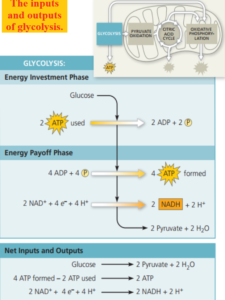
Glycolysis occurs in the cytoplasm of the cell.
It does not require oxygen.
It is an anaerobic process.
Glucose, a six-carbon sugar, is split into two smaller, three-carbon pyruvate molecules.
ATP and reduced nicotinamide adenine dinucleotide (NAD) are also produced.
Glycolysis, summarised here, actually involves about 10 reaction steps involving many enzymes.
The main steps in glycolysis are:
-
Phosphorylation:
The first step of glycolysis requires two molecules of ATP.
Two phosphates, released from the two ATP molecules, are attached to a glucose molecule forming hexose bisphosphate.
-
Lysis:
This destabilises the molecule causing it to split into two triose phosphate molecules.
-
Phosphorylation
Another phosphate group is added to each triose phosphate forming two triose bisphosphate molecules.
These phosphate groups come from free inorganic phosphate (Pi) ions present in the cytoplasm.
-
Dehydrogenation and formation of ATP
The two triose bisphosphate molecules are then oxidised by the removal of hydrogen atoms (dehydrogenation) to form two pyruvate molecules.
NAD coenzymes accept the removed hydrogens they are reduced, forming two reduced NAD molecules.
At the same time, four ATP molecules are produced using phosphates from the triose bisphosphate molecules.
This is an example of substrate level phosphorylation.
The formation of ATP without the involvement of an electron transport chain.
ATP is formed by the transfer of a phosphate group from a phosphorylated intermediate (in this case triose bisphosphate) to ADP.
Two ATP molecules are used to prime the process at the beginning, and four ATP molecules are produced, so the overall net ATP yield from glycolysis is two molecules of ATP
The reduced NAD (NADH) is used in a later stage to synthesise more ATP.
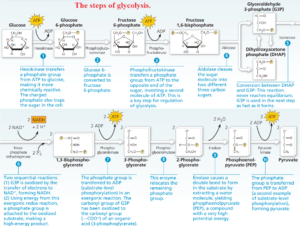
Oxidative decarboxylation (the link reaction)
It is also known as the preparatory (prep) reaction because it occurs before the citric acid cycle/Kreb cycle.
The first step in aerobic respiration is oxidative decarboxylation.
This is sometimes referred to as the link reaction, because it is the step that links anaerobic glycolysis, occurring in the cytoplasm, to the aerobic steps of respiration, occurring in the mitochondria.
In eukaryotic cells, pyruvate enters the mitochondrial matrix by active transport via specific carrier proteins.
Pyruvate then undergoes oxidative decarboxylation where carbon dioxide is removed (decarboxylation) along with hydrogen (oxidation).
The hydrogen atoms removed are accepted by NAD.
NAD is reduced to form NADH (reduced NAD).
The resulting two-carbon acetyl group is bound by coenzyme A forming acetylcoenzyme A (acetyl Co A).
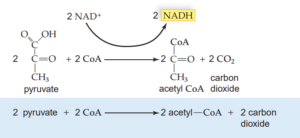
Note:
The International Union of Pure and Applied Chemistry (IUPAC) name for the acetyl group is the ethanoyl group, but the terms acetyl and acetylcoenzyme A are so widely known and used by biologists that the traditional names are retained.
Acetyl CoA delivers the acetyl group to the next stage of aerobic respiration, known as the Krebs cycle.
The reduced NAD is used in oxidative phosphorylation to synthesise ATP.
Acetyl groups are now all that is left of the original glucose molecules.
The carbon dioxide produced will either diffuse away and be removed from the organism as a metabolic waste or, in autotrophic organisms, it may be used as a raw material in photosynthesis.
The Krebs Cycle/ Citric Acid Cycle

The Krebs cycle also takes place in the mitochondrial matrix and each complete cycle results in the breakdown of an acetyl group.
Acetyl groups are all that remain of the glucose that entered glycolysis.
It is another complex multi-step pathway, summarised here.
As in the previous stages, the Krebs cycle involves;
- decarboxylation,
- dehydrogenation,
- and substrate-level phosphorylation.
The hydrogen atoms released are picked up by the coenzymes NAD and flavin adenine dinucleotide (FAD).
Carbon dioxide is a by-product of these reactions and the ATP produced is available for use by energy requiring processes within the cell.
The reduced NAD and reduced FAD produced are used in the final, oxygen-requiring step of aerobic respiration (Oxidative phosphorylation) to produce large quantities of ATP by chemiosmosis.
Acetyl CoA delivers an acetyl group to the Krebs cycle.
The 2- carbon acetyl group combines with 4-carbon oxaloacetate to form 6-carbon citrate.
The citrate molecule undergoes decarboxylation and dehydrogenation producing one reduced NAD and carbon dioxide.
A 5-carbon compound is formed.
The five-carbon compound undergoes further decarboxylation and dehydrogenation reactions, eventually regenerating oxaloacetate and so the cycle continues.
More carbon dioxide, two more reduced NADs, and one reduced FAD are produced.
ATP is also produced by substrate-level phosphorylation.
The importance of coenzymes in respiration
Respiration is a complex multi-step reaction pathway.
Coenzymes are required to transfer protons, electrons, and functional groups between many of these enzyme-catalysed reactions.
Redox reactions have an important role in respiration and without coenzymes transferring electrons and protons between these reactions many respiratory enzymes would be unable to function.
NAD and FAD are both coenzymes that accept protons and electrons released during the breakdown of glucose in respiration.
The differences between these two enzymes are:
- NAD takes part in all stages of cellular respiration but FAD only accepts hydrogens in the Krebs cycle
- NAD accepts one hydrogen and FAD accepts two hydrogens
- reduced NAD is oxidised at the start of the electron transport chain releasing protons and electrons while reduced FAD is oxidised further along the chain
- reduced NAD results in the synthesis of three ATP molecules but reduced FAD results in the synthesis of only two ATP molecules.
Coenzymes are usually derived from vitamins.
This is why, although coenzymes are mostly recycled, vitamins are an essential micronutrient.
The electron transport chain (ETC)/ Oxidative phosphorylation reaction

The hydrogen atoms that have been collected by the coenzymes NAD and FAD are delivered to electron transport chains present in the membranes of the cristae of the mitochondria.
The hydrogen atoms dissociate into hydrogen ions and electrons.
The high energy electrons are used in the synthesis of ATP by chemiosmosis.
Energy is released during redox reactions as the electrons reduce and oxidise electron carriers as they flow along the electron transport chain.
This energy is used to create a proton gradient leading to the diffusion of protons through ATP synthase resulting in the synthesis of ATP.
At the end of the electron transport chain the electrons combine with hydrogen ions and oxygen to form water.
Oxygen is the final electron acceptor and the electron chain cannot operate unless oxygen is present.
Respiration which involves the complete breakdown of glucose is therefore an aerobic process.
The phosphorylation of ADP to form ATP is dependent on electrons moving along electron transport chains.
This requires the presence of oxygen and is known as oxidative phosphorylation.
The hydrogens released from NAD and FAD could combine directly with oxygen, releasing energy from the formation of bonds during the production of water.
However, this energy could not be used to synthesise ATP.
Heat released in the exothermic reaction would simply raise the temperature of the cell.
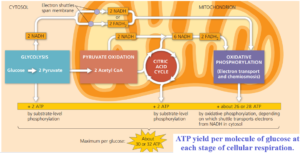
Substrate level phosphorylation
Substrate level phosphorylation is the production of ATP involving the transfer of a phosphate group from a short-lived, highly reactive intermediate such as creatine phosphate. This is different from oxidative phosphorylation which couples the flow of protons down the electrochemical gradient through ATP synthase to the phosphorylation of ADP to produce ATP.






